Saint Malachy
Prophecies about 112 popes until the end of the world.
Note: The Church does not lean on private revelation for doctrinal matters, but it does not oppose to the faithful obtaining benefit from them so long as they don't go against our faith.
This analysis focuses on the last five Popes in the context of the prophecies of Saint Malachy.
+ + +
Saint Malachy was born in Amagh Ireland in 1094, he lived a religious life as a monk, then he was ordained priest and finally Bishop. He was canonized in 1199 by Pope Clement III. His biography was compiled by Saint Bernard, a contemporaneous saint.
He made a pilgrimage to Rome and during the end of the year 1139 and the beginning of 1140 had a series of visions about 112 Popes from Celestine III, elected Pontiff in 1130 until the last Pope who is described in his list as Peter Romanus.
After the last Roman Pontiff, Saint Malachy predicts the end of the world.
The Benedictine historian Arnold Wion was the first person to mention these prophecies in his book Lignum Vitae, published in 1559.
These prophecies are short, but they have demonstrated to be very accurate, even though in the time of their publication they caused much controversy as some claimed that they were falsified.
The book of prophecies of Saint Malachy was published originally in 1969 by Colin Smythe Ltd. in England, with the title "Prophecies of St. Malachy and St. Columbkille."
Tan Books published the book in the United States in 1973 with the title "Prophecies of Saint Malachy" its author is Peter Bander.
The foreword reads like this:
In publishing THE PROPHECIES OF SAINT MALACHY, Colin Smythe Limited have produced an instructive and entertaining book.
There is great deal of instant information in Peter Bander's nutshell biographical accounts of the popes who occupied the Roman See since the year 1143 to our present time - and indeed of the antipopes as well. The remarkable way in which the visions St Malachy is alleged to have had, are shown to apply to the succesive individual popes is most amusing. Is it not the case to repeat: "Se non e vero, e ben trovato"? (If it is not true, it is well rhymed)
Whatever one may think of the genuineness of the prophecies attributed to Saint Malachy, here is a fascinating study which provides the curious reader with much profit and pleasure.
Archbishop H.E. Cardinale
Apostolic Nuncio to Belgium and Luxemburg, until recently Apostolic Delegate to Great Britain.
It is curious to think that whenever there is a Conclave, the Cardinals read these prophecies of the saint, and even though they are not ecclesiastic authority they give an idea of what has happen and of what is to occur.
Prophecies of Saint Malachy
This study is an analysis based on private revelation and observations of what is taking place now. It is not to be taken as an official position of the Church. It is good to remind us of the words of the Lord: "stay awake."
The last five popes are mentioned with the following titles:
Flos Florum
De medietate Lunae
De Labore Solis
Gloria Olivae
Petrus Romanus
Flos Florum - Flower of flowers
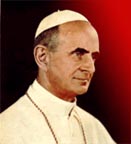 Pope Paul VI
Pope Paul VI
Pontiff from 1963 to 1978.
Giovanni Battista Montini. In his coat of arms there are three "fleurs de lis"
With great success he concluded Vatican Council II, he made rigorous reforms to the Roman Curia, he traveled the five continents and was called peregrine pope . In 1965 he was well received and accepted at his address to the UN. Author of the encyclicals opulorum progressio (1967), Humanae vitae July 24, 1968. He died in August 6, 1978, feast of the Transfiguration.
De medietate Lunae - Of the half moon
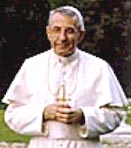 Papa Juan Pablo I ' Abino Luciani
Papa Juan Pablo I ' Abino Luciani
Pontiff for 33 days.
He was born on 17 of October 1912 in Forno di Canale, called now Canale de Agordo, he was baptized the same day by his midwife, for fear of his death, he was later baptized by a priest.
After a life dedicated to the Church as a priest, he was elected Pope during the second day of the Conclave in August 26, 1978. He died of cardiac attack in September 28 1978, thirty three days after the beginning of his papacy.
"De la media luna" Of the half moon is a very accurate description regarding his beginning and also his short pontificate. Even his name Abino Luciani means white light, it has been mentioned that the most important events of his life took place in dates of half moon.
De Labore Solis - From the toil of the sun - or - Of the eclipse of the sun.
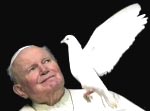 Pope John Paul II
Pope John Paul II
Pontiff from 1978 to 2005
This description fits John Paul II perfectly, since he emerged as a especial light for the Catholic Church, promoting the faith from all angles. The works of John Paul II were truly the work of God, the labor of the sun.
The second meaning of "De labore solis" is a solar eclipse, in which the sun seems to struggle in order to give its light. Perhaps the fact that John Paul II, was a very Marian Pope who had a special devotion to the Virgin Mary, the woman clothed with the sun that appears in the Apocalypse, suggests that the sun (Our Lord) has been temporarily eclipsed by the moon (Our Lady).
John Paul II was a great humanist and peacemaker, a traveler Pope, proclaimer of the gospel in more than 130 countries throughout the world, author of many apostolic letters, encyclicals and books. Canonizer of more saints in his pontificate than any other Pope in all history. During his last years as Pope he concluded his pontificate proclaiming the Holy Trinity, the Virgin Mary and the Eucharist.
Year 1997. God the Son
Year 1998. God the Holy Spirit
Year 1999. God the Father
Year 2000
24 December 1999 - 6 January 2001Great Jubilee.
Year 2002-2003. Year of the Holy Rosary, institution of the Luminous mysteries.16 October 2002 - 31 October 2003
Year 2005. The Holy Eucharist. 17 October 2004 - 29 October 2005
Gloria Olivae - The Glory of the olive
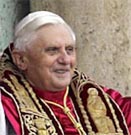
Joseph Ratzinger
Starts Pontificate in April 2005
He chose his name in honor of Saint Benedict, author of the very strict rule of the Benedictines.
His motto is "Co-worker of the Truth."
He has been known even before becoming Pope as a conservative man, ready to defend the Catholic principles that represent the truth of the teachings of Christ.
Our new Pontiff is covered under the sign of the olive according to the prophecies of St. Malachy
The branches of the olive were symbols of peace and victory for Noah after the flood. Throughout history, we know that olive branches have made crowns for kings and athletes as symbols of power and glory. The olive tree thrives in silent areas, such as the garden of olives where Jesus suffered his agony before being arrested by the soldiers.
Olive oil has anointed kings, saints, popes and in a especial way all Christians.
The leaves and the oil of the olive tree have medicinal properties, derived from the oleic acid which is an anti cancer component. The good kitchen cannot exist without olive oil. The best paints have olive oil base, to give them luster and to increase their durability.
The olive is a symbol of peace, abundance, glory and purification.
The Church has been through a period of light, and now is the the time to celebrate and pick up the fruits of the previous pontificate of John Paul. It is quite possible that they will bring many conversions and an increase in the faith especially from the young people.
With the purifying properties of the olive, our new Pontiff comes to challenge error. He presents himself exposing the truth of our faith with a special courage, he is prepared to heal the cancer of heresy, the infection of apostasy and to promote the health of our Catholic faith.
According to the prophecies of Saint Malachy, Pope Benedict XVI is the Pope before the last one, named "Gloria Olivae" which means the glory of the olive, it is to be a time of glory and rejoicing for the true Church.
Due to the straightforwardness of our new Pontiff, great opposition is expected, but the Spirit of God is with him and we are in good hands.
Petrus Romanus - Peter Roman
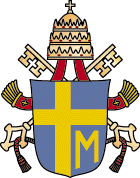
You are Peter, the rock. On this rock I will build my Church and the gates of hell will not prevail against it. I will give you the keys of the Kingdom, whatever you bind on earth will be bound in Heaven, whatever you loose on earth will be loose in Heaven. (Matthew 16:18-19)
Peter, the same as Christ, drank of the same chalice of suffering when he died as a martyr.
The body of Christ, the Church represents our Lord Jesus Christ.
The last two pontiffs will have to face the fury of the enemy who will make a violent persecution to Christianity. Faithful as Peter, the last Pontiff will take care of his flock in the midst of the attacks of the enemy.
2 Thessalonians 3-4 speaks of the apostasy of the last times before the second coming of Christ, when evil will be defying everything that is sacred. The man of iniquity, or the anti-Christ will take his seat in the temple of God.
This does not necessarily means the embodiment of the devil but if could mean the evil that is being accepted broadly when human beings who are temples of the spirit of God are being desecrated by their own wickedness.
Just as the Lord lived, taught us, gave us spiritual food and saved us by his death on the cross, the Church being the mystical body of Christ has a similar task. Therefore the church is to be persecuted, insulted and finally crucified, in preparation for the coming of the Lord.
But just as the Lord rose after his death, the Church will also be resurrected for the Glory of God.
No one knows the day nor the hour, but the Lord tells us to be ready.
The prophecies of Saint Malachy end like this:
In the persecution of the Holy Roman Church, there will reign Peter the Roman, who will feed his flock among many tribulations after which the seven hilled city will be destroyed and the dreadful Judge will judge the people.